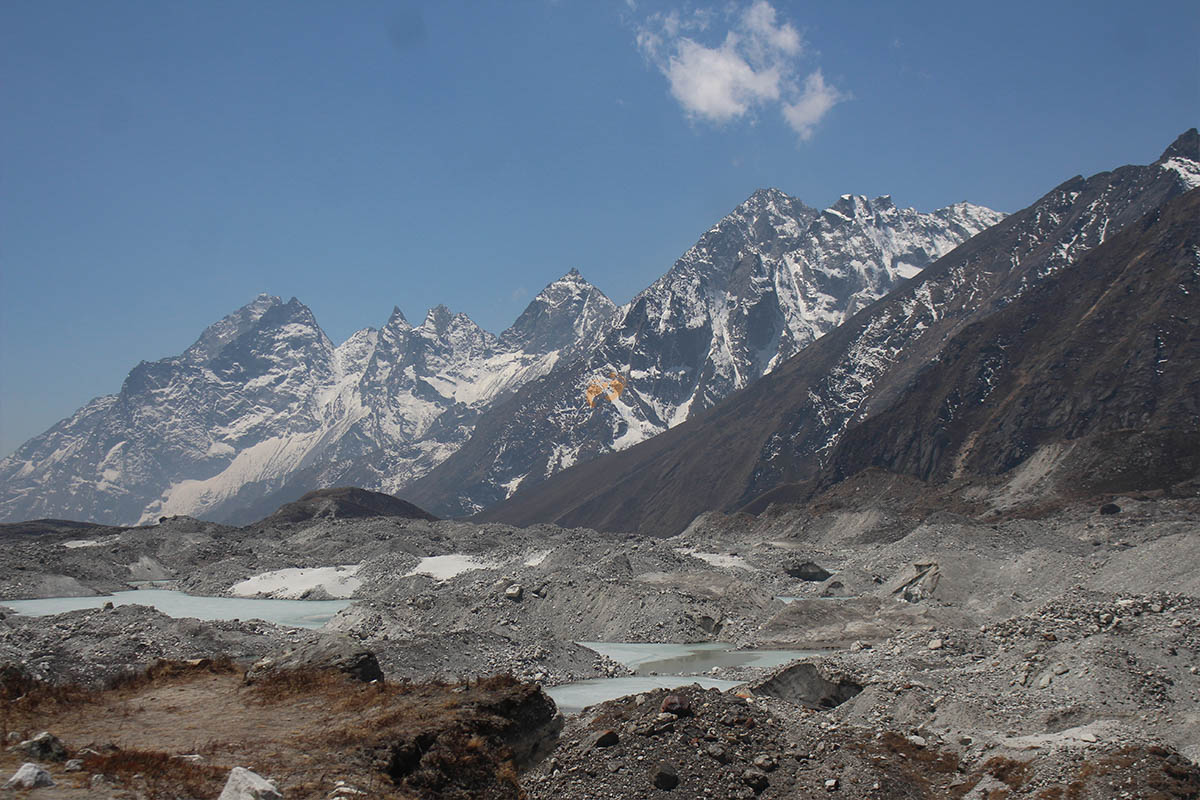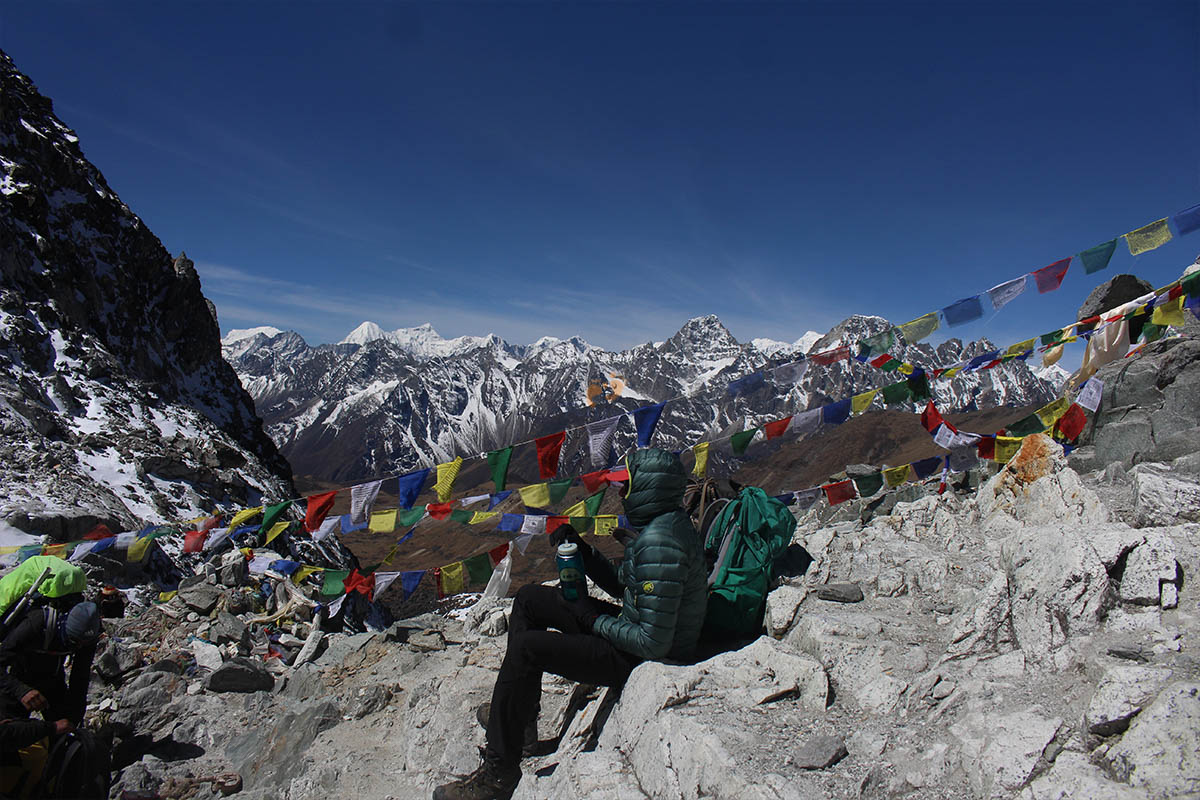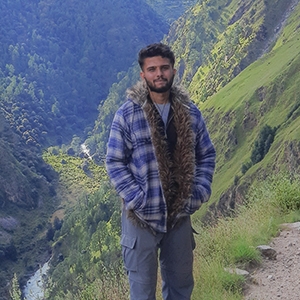Three Passes Trek Route and Highlights
The Three Passes Trek route is well-marked, but hiring a trekking guide is highly suggested to simplify bookings and trail navigation, especially during prime seasons. A guide can also offer valuable insights into the local culture and mountain life. While trekking without a guide is doable, the immensity of the mountains makes navigation more challenging than in heavily forested trails. If you join a trekking company, they will provide a trek briefing and a map. If you decide to go solo, purchase a trek map in Kathmandu.
Renjo La is typically viewed as the toughest pass when approached clockwise, while Cho La involves crossing an icy glacier where crampons are helpful. Kongma La Pass is the highest point of the entire circuit. However, weather conditions can alter the difficulty of each pass. Starting early on the days you plan to cross a pass is recommended, allowing plenty of time and avoiding the afternoon breeze.
Now, let's explore the significant daily highlights of this breathtaking trek.
Landing at Lukla Airport

Landing at Lukla airport (2,800m) is an adventure in itself and is often regarded as the world's best mountain flight due to the sensational views of several giant mountain ranges. Touching down at the world's most dangerous airport marks the origin of this extraordinary trek. Once in Lukla, you'll instantly feel the mountain atmosphere and start your journey on foot from there.
Learn more about the Lukla flight and alternative routes for this trek here.
Namche Bazar (3,440m)

Also known as the capital of the Khumbu Region, trekkers have to stay here for two nights as a part of the acclimatization process. This beautiful town provides all the vital facilities before you head to completely isolated places. Here, you will also hike to the Everest View Point (3,880m) to adapt to the thin air of the mountains and will also witness the first sight of Mount Everest along with Taboche, Lhotse, Thamserku, Kusum Khangru, and Ama Dablam. This town also provides you with options for shopping, fine eateries, best lodges, pharmacies, and ATM services.
Thame (3,800m)

Thame, a beautiful Sherpa settlement known as the village of Everest summiteers, is about a four-hour walk from Namche Bazaar. On the fourth day of the 3 Passes Trek in the clockwise direction, Thame is a major stop. Trekkers trek through a lovely rhododendron forest alongside the Bhotekoshi River. Along the way, you'll pass through the precious village of Phurte (3,500m), where you'll find a few teahouses and mani stones. Continuing, you'll reach Samde village, cross a suspension bridge, and climb further to arrive in Thame. Once there, you can visit the age-old Thame Monastery, a perfect spot to clear your mind and prepare for the upcoming days of your trek.
Lungden

At an altitude of 4,380m, Lungden is a key stop for those on the Everest 3 Passes Trek, mainly for those heading towards Renjo La Pass clockwise. The walk from Thame to Lungden takes about four and a half hours. Since the next day involves crossing a high pass, you can take a short hike upon reaching Lungden to prepare better. This hike, heading east, offers views of peaks like Kyajo Ri, Nupla, Paniyo Tapa, Kongde, and more. If you hike quickly, it can be completed in about 2.5 hours. Lungden has a few teahouses that offer good services to trekkers. The village remains less commercialized than other famous trekking spots in the Everest region, offering a genuine Himalayan lifestyle understanding.
Renjo La Pass

At an altitude of 5,360m, Renjo Pass is one of the world's most sensational Himalayan passes. Leaving Lungden early in the morning, we head northeast to reach the pass's summit. The morning starts with cold temperatures, but the first glow of sunlight on the surrounding mountains offers warmth and motivation. Find your speed, focus on breathing, and avoid rushing. Dress warmly as the wind can pick up unexpectedly. Upon reaching the summit, you'll be rewarded with views of Mt. Pumori, Lhotse, Nirekha, Baruntse, Arkam Tse, Nuptse, Changtse, Lobuche, Makalu, Everest, and other peaks. Renjo Pass provides an exceptional viewpoint for viewing Mount Everest. You'll see the stunning Angladumba Tsho and Relama Lake at the pass's base. After spending some time at the top, you'll descend to Gokyo village (4,790m) for an overnight stay. The trail down is steep and narrow, so proceed cautiously, follow your guide, and stay close to your squad.
Gokyo Lakes and Gokyo Ri
A rest day at Gokyo Village is recommended before tackling the next mountain pass. The exquisite Gokyo Lake is a major highlight of the Three Passes Trek. Allow your body to acclimatize in Gokyo village, enjoy the views, and treat yourself to bakery items at 4,790m.

Early in the morning, set out for a hike to Gokyo Ri (5,350m), which typically takes 4 to 5 hours round trip, depending on your pace. You'll be rewarded from the summit with sceneries of the Gokyo Lakes, Nzoumba Glacier, and the surrounding high mountains.
Nzoumba Glacier

Before crossing Cho La Pass, you must cross the vast Nzoumba Glacier. This crossing leads to the small village of Thangnak, where you'll spend the night before endeavoring the second pass of the trek. As the longest glacier in the Himalayas, stretching about 36 kilometers from its origin below Cho Oyu mountain, it flows southwards through soaring peaks and rough terrain, eventually feeding into the Dudh Koshi River. The glacier's sheer size and rugged beauty leave a lasting impression, reminding us of our smallness compared to these majestic natural marvels.
Cho La Pass

We start early from Thangnak to ensure we traverse Cho La Pass (5,420m) on time. This pass unites Gokyo Valley with the Everest Base Camp trail and involves a high-altitude trail that includes crossing a glacier, navigating rocky landscapes, and sometimes trekking through snow. After reaching the pass's summit, we descend an icy glacier, so crampons are recommended for this section. An early start is important to avoid afternoon winds and to ensure enough daylight for the crossing. From the top, the 360-degree views of the surrounding Himalayas are astonishing, with snow-covered mountains extending as far as the eye can witness.
Everest Base Camp and Kalapatthar
After traversing Cho La Pass, we will stay at Dzongla and prepare for the trek to Everest Base Camp. Following the northeast route, we will connect to the main EBC trail. We will spend a night in Lobuche (4,990m) and head towards base camp the next morning, passing through Gorakshep, the last settlement on the EBC trek. The trail goes through the Khumbu Glacier, encircled by massive mountains. After reaching base camp, if time and fitness allow, you can hike to Kalapatthar (5,600m) the same day for a sundown view. Otherwise, you can rest overnight at Gorakshep, start the hike to Kalapatthar the next morning, and then return to Lobuche for an overnight stay.
Kongma La Pass

Kongma La (5,550m) is the final pass to cross after visiting Everest Base Camp. We commence early from Lobuche, crossing the Khumbu Glacier to reach the pass base. If there's no snow, the trail is safer and more open, but heavy snow can make the narrow, rocky path challenging. From the base, follow the left side to reach the summit. At the top, you’ll be rewarded with sensational views of Ama Dablam, Lhotse, Makalu, Lobuche, Cho Oyu, Island Peak, Peak 38, Baruntse, and more. After enjoying the views, descend to Chukung village. Alternatively, if you’re fit, you can take a shortcut to Dingboche village (4,410m) on the same day. The next morning, head to Pangboche, then Namche Bazaar, and finally trek back to Lukla for your flight back to Kathmandu.
Preparation for the Everest Three Passes Trek
Preparing for the Everest Three Passes Trek involves thorough planning, physical training, and smart packing. Trekkers will encounter mixed weather conditions, challenging terrains, and altitude sickness risks. Proper acclimatization is crucial, as is equipping yourself with the right gear, such as thermal clothing, durable boots, and trekking poles. Hiring a proficient guide and porter can enhance your experience by offering cultural understanding and ensuring safety on the journey. Besides, carrying a basic first aid kit and knowing the symptoms of altitude sickness can help prevent health issues.
When it comes to preparation, it's not just about physical enthusiasm, mental preparation is equally essential. For physical training, you can focus on the following:
Strength Training
Include strength training in your routine to develop the muscles vital for the trek. Focus on your legs, core, and upper body. Exercises such as squats, lunges, deadlifts, planks, and push-ups will assist you in carrying your backpack and trekking through vertical trails.
Acclimatization
Identify the significance of acclimatization. Follow your guide's advice and plan rest days into your trek, particularly at higher elevations, to aid your body in adjusting to the low oxygen levels and decrease the chance of altitude sickness.
Build endurance and stamina
Commence your training at least three to six months before the journey. Concentrate on improving your cardiovascular strength by engaging in activities such as running, cycling, swimming, or hiking. Aspire for a minimum of 30 minutes of cardio exercise three to five times a week.
Start hiking before your three passes trek

On weekends, go for hikes, slowly extending the distance and altitude gain. If doable, bring along a weighted backpack to imitate trekking conditions. Doing so will aid your body in adapting to the added weight, improving both your balance and stamina.
Furthermore, mental strength holds equal significance to physical strength. Prepare yourself to tackle the extended days, fluctuating weather, and physical effort with a positive mindset. Familiarize yourself with the route, local culture, and foreseen experiences during the trek. Grasping the journey's challenges and grandeur can strengthen your motivation. Acknowledge that trekking at high altitudes can be unpredictable. Remain versatile in your plans and attuned to your body's signals. It's perfectly acceptable to schedule additional rest days if needed.
Best season for Three Passes Trek
Spring (March-May)
Spring blesses the Everest region with mild temperatures and cloudless skies, creating an optimal atmosphere for trekking. During the day, temperatures balance between pleasant and mildly warm, while nights maintain a refreshing coolness without dipping into a freezing environment. This season grants trekkers outstanding visibility, affording open panoramas of the glorious Himalayan peaks, such as Everest, Lhotse, and Ama Dablam. Photographers will have ample opportunities to capture spectacular shots of the landscape. Additionally, embarking on the trek during spring offers the chance to fully immerse oneself in the deep local culture and partake in the region's lively festivities.

Autumn (September-November)
Autumn emerges as the major season for trekking in Nepal owing to its constant weather patterns. By September, the monsoon showers have typically dispersed, ushering in days characterized by clarity and dryness. However, it's worth noting that due to escalating global warming, September may still witness occasional rainfall and haziness. Nevertheless, the landscape undergoes a dazzling transformation as the surrounding flora transitions into a kaleidoscope of golden hues, painting the terrain in the spirited colors of fall. With pleasant daytime temperatures and rejuvenating nights, autumn offers trekkers optimal conditions for their high-pass journey. The trails are marked, and the likelihood of encountering snow or ice on the high passes is minimal.
During winter (December to February), the Everest region experiences chilly temperatures and irregular snowfall, rendering trekking more burdensome. Nonetheless, this season presents a viable choice for seasoned trekkers in search of isolation and stunning winter vistas. On the other hand, the monsoon season (June to August) brings overflowing rainfall and muddy trails, posing significant challenges and dangers for trekking. Consequently, it is typically advised to avoid trekking in the Everest region during this period.
Accommodation during Three Passes Trek

Accommodations along the Everest Three Passes Trek offer trekkers a comfortable retreat amidst the sensational beauty of the Himalayas. Teahouses and lodges are the primary lodging options, providing essential yet inviting accommodations. Teahouses, in particular, are charming lodges offering either dormitory-style or private rooms with shared bathrooms. Featuring wooden interiors and combined dining areas, these facilities provide a comfortable space for trekkers to enjoy hearty meals and connect with fellow adventurers. While amenities may vary, teahouses typically provide clean bedding, warm blankets, and the option for hot showers, often for an added fee. Some teahouses may offer conveniences such as Wi-Fi and charging ports, although these amenities are more common in lower-altitude villages. While some trekkers may choose to camp along the route, booking with a reputable trekking agency is advisable. This ensures that experienced staff can be arranged for your Three Passes journey. Especially during peak seasons, trekking agencies can pre-book accommodations and provide an unforgettable experience for trekkers.
Food and drinking water during Three Passes Trek
There's no need to worry about food options during this trek. Whether in Lukla or Gorakshep, various options of culinary choices await you on the menu. Along the way, you'll encounter excellent cafes and bars up to Namche, catering to multiple hungers. Additionally, teahouses offer a decent selection of meals, ranging from basic Dal Bhat to Pizza and Spaghetti. However, it's worth noting that the taste may be less delicate at higher altitudes compared to fancier restaurants. It's advisable to avoid deep-fried foods during passes trekking and instead choose a regular intake of Dal Bhat for a well-balanced diet. Meat options are readily available until Namche Bazaar, but afterward, choosing vegetarian options or incorporating eggs into your daily meals is recommended. For vegan trekkers, simply inform the kitchen staff or your guide of your dietary preferences before meals.
Furthermore, it's wise to refrain from drinking cold water in higher areas. Teahouses typically provide a large pot of hot water daily to meet your hydration needs, you just have to buy that. Remember to carry a water filter or purification tablets to treat tap or mineral water during your trek. Know more about purification of water during the trek, here.
Packing list for Everest Three Passes Trekking
- Thermal tops and bottoms
- Pants and fleece jackets for insulation
- Waterproof and windproof pants and jackets
- Reliable down jacket
- Waterproof boots with good ankle support
- Neck buff, warm hat, gloves, and sunglass
- High-quality pair of socks
- A medium (40ltr) backpack to carry your personal items
- Backpack cover (waterproof)
- Sleeping Bag around minus 20 degrees Celcius. You can also rent a good sleeping bag in Kathmandu
- Crampons for icy terrains
- Trekking poles
- Water bottle, purification tablets
- Headlamp, basic medicines
- Internet and ATM services during Three Passes Trekking
Internet and ATM services during Three Passes Trek
A Nepali SIM card works up to Namche Bazaar. You can purchase an Ncell SIM card with a data pack for NPR 700 in Kathmandu. After Namche, teahouses offer internet access via an Airlink Card, which costs NPR 800 for 24 hours. You can also find cards valid for 48 hours at NPR 1,300 in some locations.
Namche is the last reliable stop for ATMs. You can withdraw Nepalese cash either in Lukla or Namche Bazaar. Although there is an ATM in Dingboche, it can be unreliable at 4,410m, especially in emergencies, so it's wise to withdraw enough cash in Namche.
Tipping during Three Passes Trek
Tipping is important during your trek in the Everest Region, especially on the Three Passes Trek. After your trek, it is expected to tip your guide and porter. The standard tipping rate ranges from NPR 1200-1800 per day for porters and NPR 2000-2200 per day for your trek guide. It will be highly appreciated if you are satisfied with the service and wish to give more.
What are the permits for Everest Three High Passes Trek?
You can obtain two major permits for the Three Passes Trekking at Lukla before you start from the main Everest trailhead.
Sagarmatha National Park Permit
You can also get this permit from the Tourist Service Center at Bhrikutimandap, Kathmandu.
For SAARC nationals NPR 1,500
For foreigners NPR 3,000
Khumbu Rural Municipality Permit
The Khumbu Municipality imposes a fee of NPR 2,000 (USD 20) per entry for tourists. This fee applies not only to trekkers but also to tourists visiting the region by helicopter.
Contact us for further information about Everest Three Passes Trekking and other best treks in Nepal.














